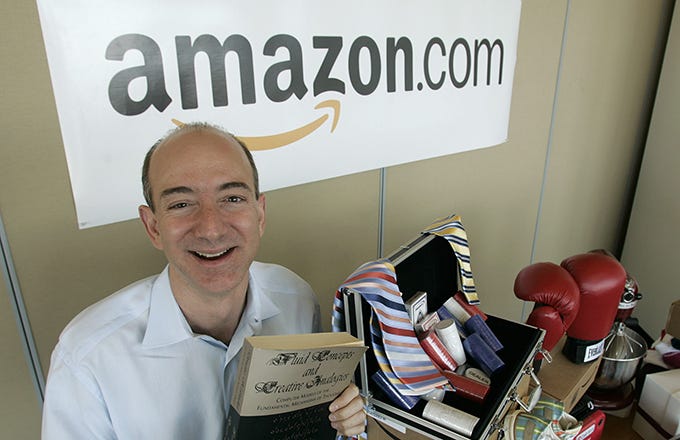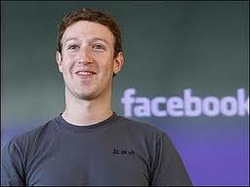SUCCESS
SUCCESS
Jeff Bezos: Success Story

Jeff Bezos: Success Story

When Jeff Bezos founded Amazon.com in 1994, the age of the online-only retailer appeared to be far off.
In August of 1994, The New York Times published an article that opened with the question “Has the Internet been overhyped?” The article cast doubt on figures that stated that 20 million people were using the Web, quoting authorities who said the number was closer to two million, speculating on the consequences awaiting companies that had wasted money on online projects.
Unlike the New York Times, Bezos was bullish about the business potential of the Internet. While rising through the ranks at a meteoric clip at D. E. Shaw in the early ‘90s, he had begun to develop the idea behind Amazon. All that remained was to determine which type of business had the most potential. (For more, see: 10 Facts You Didn’t Know About Amazon.)
One factor that drove Bezos’ ruminations was a then-recent U.S. Supreme Court ruling that mail-order businesses were exempt from sales taxes in states in which the companies didn’t have a physical presence. He started researching mail-order businesses and their products. From there, he winnowed the opportunities down to smaller and smaller lists, finally deciding to get into the book business, because of the millions of titles in print.
He talked the idea through with friends and family, who offered financial and moral support. The details of the business came into focus for Bezos on a cross-country drive from Texas to Seattle. Setting up shop in the garage of his Seattle home, he initially named the business Cadabra.com, as in the magician’s phrase “abra-cadabra,” but later changed it because of its similarity to “cadaver.”
With a new name and a full library of books for sale, Amazon.com opened for business, and the orders began pouring in almost immediately. (For more, see: Amazon Never Makes Money But No One Cares.)
"Within the first few days, I knew this was going to be huge," Bezos said of the launch. "It was obvious that we were onto something much bigger than we ever dared to hope."
In its first two months, the advantages of being online were apparent. Amazon sold books in all 50 states as well as more than 45 countries, bringing in $20,000 in sales per week by late 1995.
Another big advantage to being online was the ability to sell merchandise that was held in the warehouses of book makers and suppliers. That allowed Amazon to offer a nearly infinite inventory, without most of the associated costs.
Bezos knew that the company’s initial success would create imitators and competitors. The keys to Amazon’s survival, Bezos realized early on, would be innovation and size. One reason that he’d chosen the name Amazon is because it's the biggest river in the world. His plan, even though Amazon initially focused on books, was to make the site into the biggest store in the world. (For more, see: 10 Facts You Didn’t Know About Amazon.)
By October 1995, Bezos felt confident enough in the business to seek capital with an initial public offering (IPO), which it completed in May of 1997. Even as it solicited investors, Bezos warned them that he didn’t expect the company to earn a profit for four to five years. Instead, he planned to heavily reinvest all surplus revenue into growing the business.
With low barriers to entry in the online retail market and the number of internet users growing exponentially every year in the mid- and late-‘90s, Bezos motto for Amazon at the time was summed up in three words “Get Big Fast.”
He followed through on that by investing not just in technology and new initiatives, but by purchasing a wide range of competitors, potential competitors and complimentary businesses over the next few years. That investment paid off, and gave the company a leadership position in online retail, a sector that simply didn’t exist ten years earlier. Amazon attained such a level of popularity that Time magazine named Bezos its 1999 Person of the Year.
And while Amazon’s long and winding trek to profitability irked a few investors, the strategy served the company well, especially when the dot-com bubble burst in the beginning of 2000, wiping out a large number of Amazon’s competitors.
By the fourth quarter of 2001, Bezos announced the company’s first profit—a scant $5 million, or one penny per share. But that profit came on revenues of more than $1 billion.
By 2001, the dot-com bubble had burst, and even Amazon had to retrench and reevaluate. The retrenching came in the form of layoffs in which the company shed 1,500 employees. The reevaluation led Bezos to look for ways to diversify Amazon’s business model.
One of the areas of diversification was the Amazon Marketplace, which let Amazon customers sell their used books, and other products alongside Amazon’s own offerings. To date, Amazon’s used-items marketplace is still the largest in the world. (For more, see: How We'll All Be Amazon.com Customers Eventually.)
Ten years after the New York Times doubted that 20 million people used the Internet on a regular basis, there was no denying that it had become a defining force in American culture. By 2004, roughly 60% of U.S. households had i\Internet access, and that number was growing. And Amazon, which now offered a wide array of products from books and CDs to clothing, electronics and more, was uniquely positioned to take advantage of the growing number of Americans who were shopping online. In 2004, Amazon brought in revenues of $6.9 billion, which increased to $8.5 billion in 2005.
In addition to growing, Bezos’ own experience with displacing entrenched industry giants led him to continue to experiment with new business lines and new services. Some, like Amazon’s foray into jewelry, didn’t pan out. But others, such as the Amazon Prime program, succeeded spectacularly. The program, which it introduced in 2005, offered free two-day shipping within the continental United States for a $79 annual fee. The program’s success led Amazon to launch it in Germany, Japan, the United Kingdom, France, Italy and Canada over the next eight years. Prime succeeded in keeping customers loyal and made it even harder for other online retailers to compete.
With its place at the top of the online retail world secure, Amazon began to look into other avenues – one of which was technology development. That business began, as had Amazon, with books. The Amazon Kindle, introduced in 2007, was a lightweight device for reading electronic books that was largely responsible for the creation of the e-book market in the U.S. and abroad. (For more, see: An Overview of Businesses Owned by Amazon.)
Four years later, Amazon entered the tablet market with the Kindle Fire, a low-cost alternative to the iPad, which was seen by many as a deliberate loss leader to help the company sell its vast catalogue of digital content.
Those new businesses, along with forays into smartphones, groceries, television series, cloud storage, aerial drones and social networking made Amazon not just the biggest online retailers in the business but one of the premier tech companies in the U.S. With 2014 revenues of $88.8 billion, it’s also made Bezos and Amazon a lot of money.
SUCCESS STORY OF Mark Zuckerberg , Founder of Facebook

Mark Zuckerberg, born May 14, 1984, was a Harvard undergraduate when he started the Facebook social networking website. An early fan of computers who had developed a "smart" mp3 player in high school, Zuckerberg had previously been reprimanded by the Harvard administration for his Facemash site, a Harvard-specific photo rating site that operated like HotOrNot.com but used photographs taken from Harvard's online facebook, without the subjects' permission. (A facebook, lower-case, is a collection of student photographs designed to introduce students to each other.)
In February of 2004, he started "The Facebook," which took the goals of those lower-case traditional facebooks and combined them with the social networking of Myspace-like sites. Unlike Facemash, The Facebook was opt-in -- any Harvard student could create an account, and by the end of the month, more than half of the undergraduates had done so. Zuckerberg expanded the service quickly, offering it to all Ivy League schools by the end of the spring and more schools the following semester. The Wirehog site was created as a companion filesharing site for Facebook users, and by the end of 2004, The Facebook had over one million registered users.
The advertising revenue made it easier to raise venture capital, and Zuckerberg and his associates purchased the facebook.com domain from its previous holder and dropped the "The" from the site's name. Over time, Facebook became more and more inclusive, opening its doors to all college students, faculty members, and alumni (anyone with a confirmed educational-domain email address), and in 2006 added networks for high school students. Since fall of 2006, the site has been open to anyone who wishes to join -- a shift away from the student-centric origins which many users have decried.
Meanwhile, a Craigslist-like Facebook Marketplace has been added to the site, along with a platform for offering applications. Microsoft purchased a 1.6% stake in the company for $240 million in October of 2007, and the following month the Facebook Beacon service premiered -- a controversial initiative that blends marketing and social networking, which has come under considerable criticism for the way that it can broadcast information about a user's activity outside of the Facebook site, without adequately warning them.
Zuckerberg moved to Palo Alto to operate Facebook full time, taking a leave of absence from Harvard; the Facebook offices now occupy four downtown buildings.
"a young man who successfully connects everyone in the world .. really great discoveries in this era.."
In February of 2004, he started "The Facebook," which took the goals of those lower-case traditional facebooks and combined them with the social networking of Myspace-like sites. Unlike Facemash, The Facebook was opt-in -- any Harvard student could create an account, and by the end of the month, more than half of the undergraduates had done so. Zuckerberg expanded the service quickly, offering it to all Ivy League schools by the end of the spring and more schools the following semester. The Wirehog site was created as a companion filesharing site for Facebook users, and by the end of 2004, The Facebook had over one million registered users.
The advertising revenue made it easier to raise venture capital, and Zuckerberg and his associates purchased the facebook.com domain from its previous holder and dropped the "The" from the site's name. Over time, Facebook became more and more inclusive, opening its doors to all college students, faculty members, and alumni (anyone with a confirmed educational-domain email address), and in 2006 added networks for high school students. Since fall of 2006, the site has been open to anyone who wishes to join -- a shift away from the student-centric origins which many users have decried.
Meanwhile, a Craigslist-like Facebook Marketplace has been added to the site, along with a platform for offering applications. Microsoft purchased a 1.6% stake in the company for $240 million in October of 2007, and the following month the Facebook Beacon service premiered -- a controversial initiative that blends marketing and social networking, which has come under considerable criticism for the way that it can broadcast information about a user's activity outside of the Facebook site, without adequately warning them.
Zuckerberg moved to Palo Alto to operate Facebook full time, taking a leave of absence from Harvard; the Facebook offices now occupy four downtown buildings.
"a young man who successfully connects everyone in the world .. really great discoveries in this era.."
SUCCESS
![SUCCESS]() Reviewed by moviebuzz
on
August 06, 2018
Rating:
Reviewed by moviebuzz
on
August 06, 2018
Rating:





No comments: